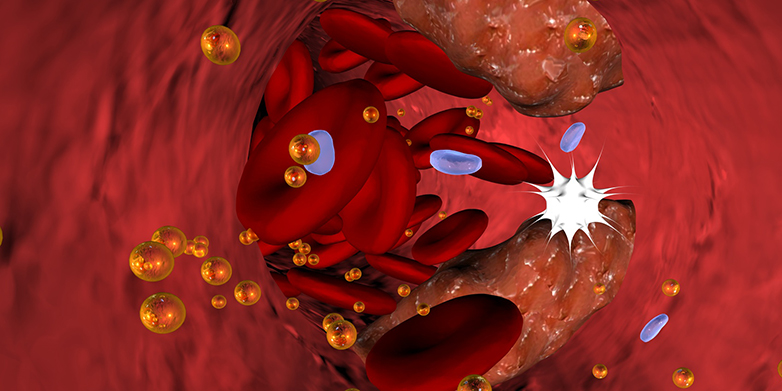ETH researchers have synthesised fatty acids in the laboratory that result from oxidative stress in the body. The laboratory variants turned out to be more potent anti-inflammatories than the natural ones, and have now been patented.

It is a hotly debated, highly researched subject that has taken on the semblance of a religious war: what are good and what are bad fats? But research from ETH Professor Manfred Kopf’s group published in recent years about fatty acids and their role in inflammatory diseases has turned certain dogmas upside down: the group found that certain oxidised fatty acids actually inhibit inflammation.
Inflammatory – or not?
Previously, many scientists had assumed that oxidised fatty acids cause and promote inflammation. An example is the low-density lipoprotein (LDL), a delivery vehicle for cholesterol and fatty acids that every cell needs and takes from the blood. Excessive amounts of LDL cause atherosclerosis. This is an inflammatory process in which foam macrophages (scavenger cells) that incorporate too much LDL or other lipids are deposited on artery walls and form plaque. If the plaque is released into the bloodstream, it can become stuck in the small blood vessels, causing a stroke or heart attack.
LDL is regarded as a ‘bad cholesterol’ in contrast to high-density lipoprotein (HDL), the ‘good cholesterol’, and is considered particularly dangerous when the fatty acids in LDL are oxidised.
Oxidised LDL suppressed inflammation
Kopf and his group looked at the general question of how fatty acids influence inflammatory processes in the body; they were particularly interested in the role played by oxidised lipids.
Slowly but surely through experiments on mice, the researchers tracked down the phenomenon. When the team put scavenger cells (macrophages) in a cell culture and fed them both LDL and the oxidised form, they got an unexpected result: the oxidised LDL inhibited the secretion of pro-inflammatory signal substances in the macrophages, which suppressed the inflammation.
“This finding was surprising. It was contrary to the conventional school of thought and was difficult to publish, especially as some publications had come to the conclusion that oxidised fatty acids promote inflammation,” recalls Kopf.
New hypothesis tested
He and his group therefore had to establish a new hypothesis: “When fatty acids are burned, different oxidisation products form, which inhibit some inflammation,” summarises the ETH professor.
The ETH researchers, in collaboration with Professor Köfeler’s group at the University of Graz, discovered that dozens of different types of oxidation products are formed when fatty acids are oxidised. Their composition depends on the duration of oxidation and the oxidising agent.
Fifty times more potent
ETH chemistry professor Erick Carreira and his group ultimately succeeded in recreating some of these lipids in the laboratory, among them two epoxyisoprostanes (EI and EC). In terms of their chemical structure, these are very similar to prostaglandins, which are formed in the body through spontaneous oxidation of arachidonic acid – found in animal fat, for example. But unlike the pro-inflammation prostaglandins E2 and A2, the researchers found that the two epoxyisoprostanes EI and EC were anti-inflammatory.
Carreira and his team also found new synthetic pathways to change EC chemically. One variant, which the researchers named cyclo-EC, revealed itself in tests to be a particularly potent anti-inflammatory, with an efficacy 50 times higher than that of a known endogenous EC-like lipid. Through experiments on mice, the researchers were able to show that EC and cyclo-EC could mitigate the effects of bacterial pneumonia. They also discovered how the anti-inflammatory effect in macrophages comes about.
Hopes to continue
Kopf and Carreira have now patented the substance cyclo-EC and its synthesis route. “This substance has a very high potential for use against various inflammatory diseases, such as psoriasis and colitis, or even autoimmune diseases, such as multiple sclerosis,” says Kopf.
“The patent could help make pharmaceutical companies aware of this drug class.” The researcher hopes that he can persuade a company to drive further development. “Currently, there is still no pharmacokinetic study, which is why companies are hesitant to address it,” he admits. Such studies will seek to clarify how a drug spreads through the body and how quickly it degrades.
For the development of cyclo-EC, Kopf, Carreira and their teams were one of the five finalists for the external page Spark Award 2015 at ETH Zurich.
Reference
external page Cyclic oxidised phospholipid for the treatment of inflammatory diseases Licensing Opportunity ETH Zürich, Reference 2013-086, Institute of Molecular Health Science, Manfred Kopf, and Laboratory of Organic Chemistry, Erick M Carreira.
Comments
No comments yet